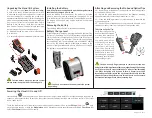
T
HEORY
748221-L Rosemount Analytical December 2000
29
Model 7D Thermal Conductivity Analyzer
the board and the functions of its main components follows. Refer to schematic
652813 at the rear of this manual.
The purpose of the Isolated Current-Output Board (PN 625816) is to convert an input
signal of 0 to -5 V to an isolated output signal of 4 to 20 mA. With a zero voltage at
the input, R6 is adjusted so that the output at AR1 is 1 V. The gain of AR1 is .8 so
that an input of 0 to -5 V is converted to 1 to 5 V. This voltage is fed to a variable
output level-inverter consisting of AR2, Q1, Q2, and T1. T1 has two identical output
windings, each with a rectified DC output. One is used to provide feedback to the
inverter input of AR2. The other is used as an isolated output to drive AR3 and Q3
with a 1 to 5 V signal across R16. Trim-pot R17 is adjusted to provide a span of 4 to
20 mA. This current is presented to the collector of Q3 and is capable of driving loads
of up to 1500 ohms.
5.2.4 B
RIDGE
P
OWER
S
UPPLY
The regulated, adjustable voltage required for the thermal conductivity bridge (Section
5.1) is provided by the Bridge Power Supply (PN 613560). It consists of a power
transformer, fullwave rectifiers CR1 and CR2, voltage regulator Q1, and an RC filter
network. Bridge voltage, as measured between bridge terminals 1(+) and 2(-), is
adjustable from 5 to 13 VDC via R2. Proper setting depends primarily on filament
material: 3 to 4 VDC for tungsten; 5 to 12 VDC for Hitempco. Bridge voltage is
factory-set as required for the application (see Data Sheet) and normally does not
require readjustment unless the power supply is replaced.
5.2.5 ±15 V
OLT
P
OWER
S
UPPLY
The ±15 Volt Power Supply (PN 619714) plugged into J101 of the Master Board,
provides power for the various circuits. As shown in drawing 619710, power
transformer T1 has three secondary that are used as follows:
38 VAC
CENTER
-
TAPPED SECONDARY
Powers both 15 volt supplies through diode bridge CR1 and filter capacitors C1 and C4.
The adjustable positive regulator, VR1, is set by voltage divider R1, R2 and R3 and its
output is applied to pin A of the circuit board and to test point TP1. Potentiometer R2
should be adjusted to +15.5 VDC ±50 mVDC.
The negative DC, regulated by VR2 is applied to pin D of the circuit board.
The center tap is the common reference for both the +15 and -15 volt supplies and is
applied to pin R of the circuit board and to test point TP2.
Both outputs are used for individual amplifiers on the various circuit boards.














































